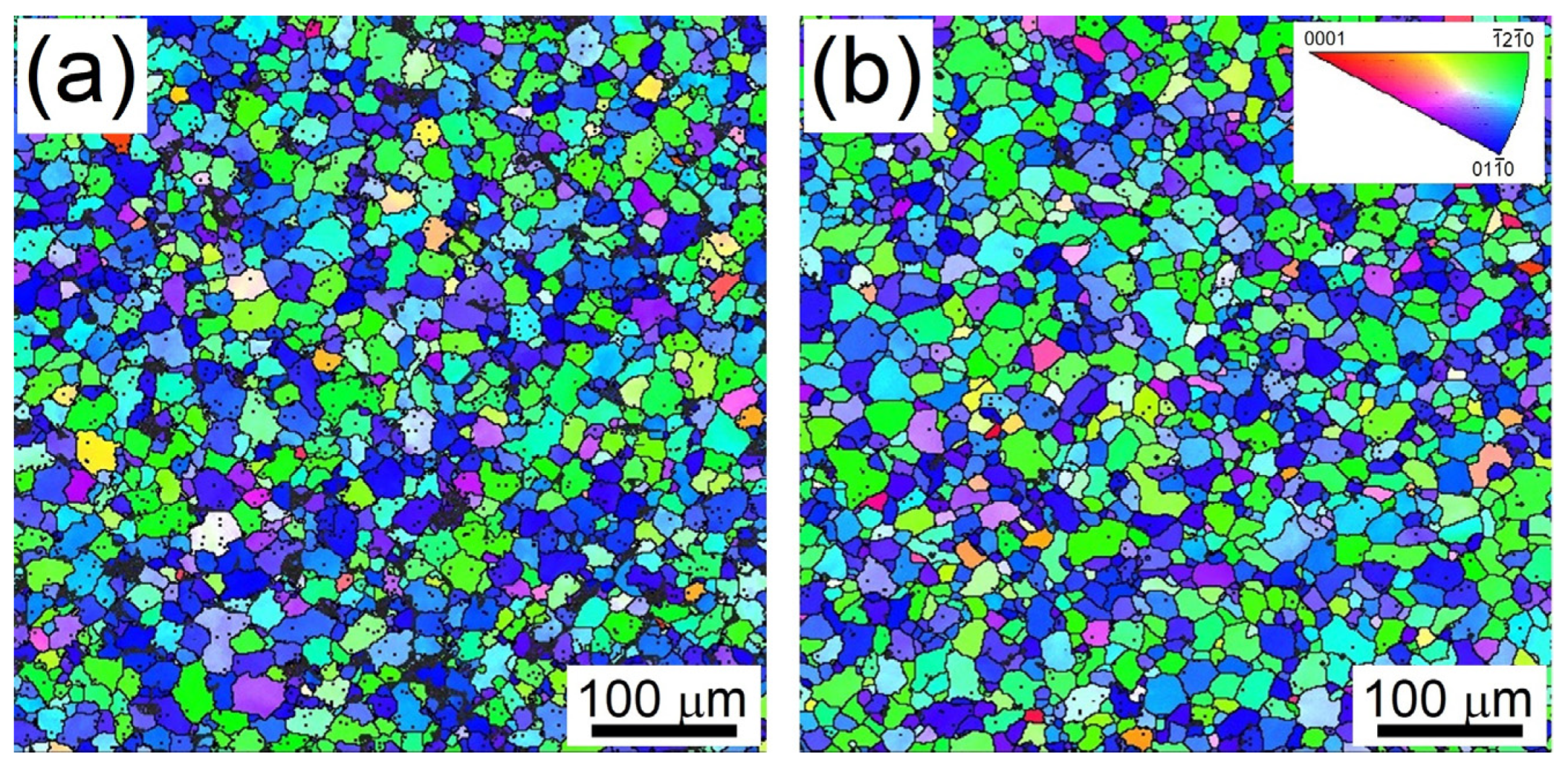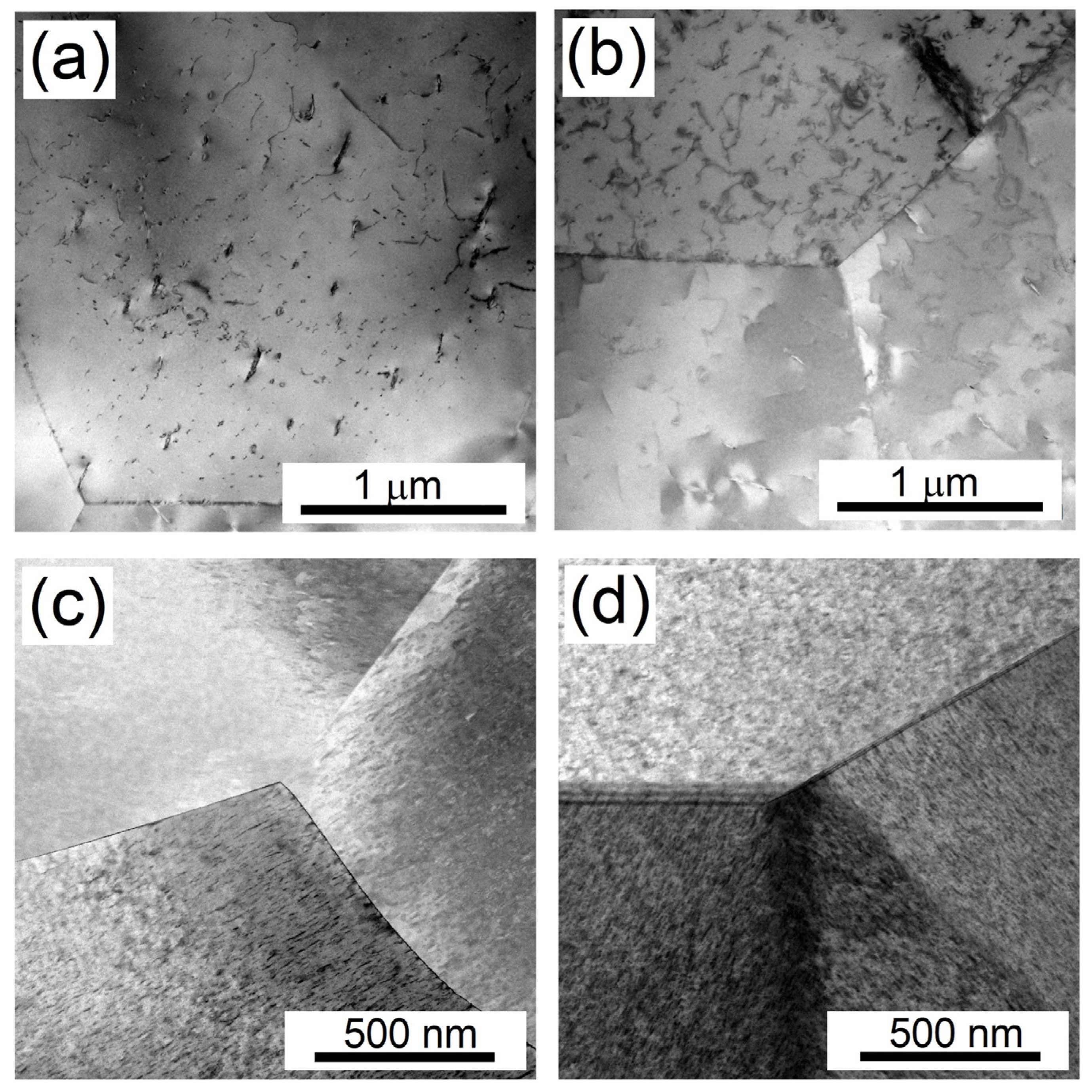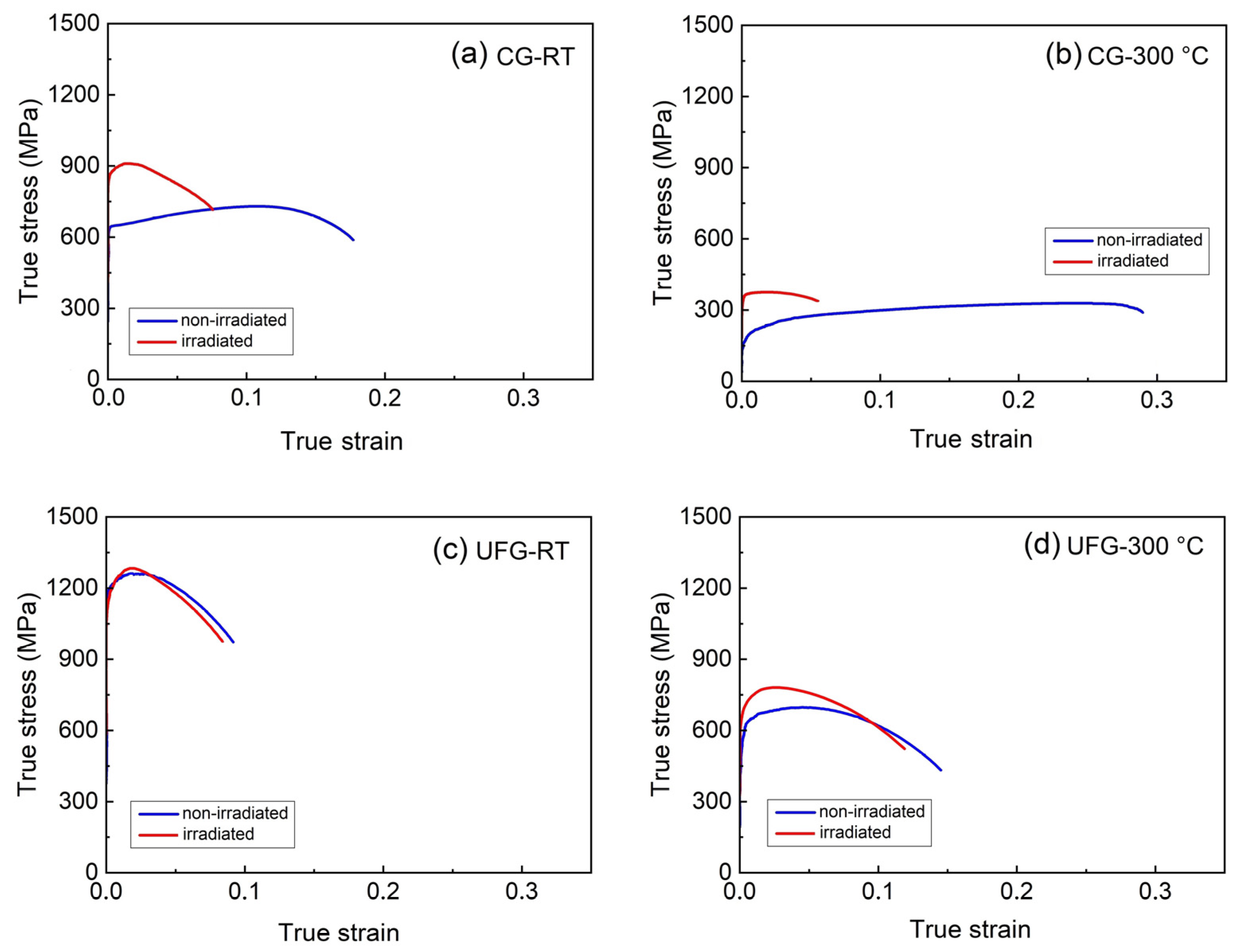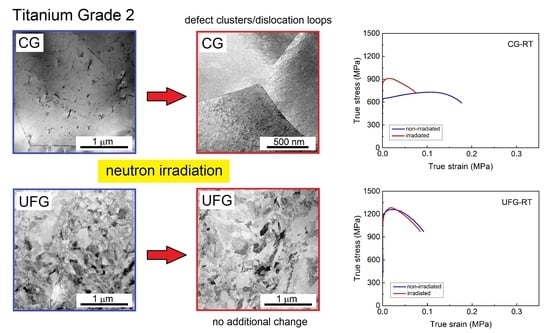Influence of Neutron Irradiation on Microstructure and Mechanical Properties of Coarse- and Ultrafine-Grained Titanium Grade 2
Abstract
:1. Introduction
2. Materials and Methods
3. Results
3.1. Microstructure of Irradiated and Non-Irradiated Ti Grade 2
3.2. Mechanical Properties of Irradiated and Non-Irradiated Ti Grade 2
4. Discussion
5. Conclusions
- Neutron irradiation significantly increases the strength and decreases the ductility of coarse-grained Ti Grade 2 as a result of the high density of defect clusters/dislocation loops created in the structure upon irradiation.
- Neutron irradiation has almost no influence on the mechanical performance of UFG material. No radiation-induced changes in microstructure were observed by TEM.
- UFG Ti is resistant to radiation damage in terms of ductility.
- Ultrafine-grained materials exhibit a high potential for applications in harsh radiation environments.
- Long-term thermal stability of the UFG microstructure under irradiation is also critical.
Author Contributions
Funding
Data Availability Statement
Conflicts of Interest
References
- Ivanov, L.I.; Platov, Y.M. Radiation Physics of Metals and Its Applications; Cambridge International Science Pub.: Cambridge, UK, 2004. [Google Scholar]
- Haley, F.A.; Younger, C.L. Irradiation effect at cryogenic temperature on tensile properties of titanium and titanium-base alloys. In Proceedings of the Symposium on the Effects of Radiation on Structural Materials Sponsored by the American Society for Testing and Materials, Niagara Falls, ON, Canada, 29 June–1 July 1970. [Google Scholar]
- Stankovic, S.J.; Ilic, R.D.; Davidovic, D.M.; Petrovic, M.; Tadic, S.; Kovacevic, M. Radiation Absorption Characteristics of Titanium Alloys. Acta Phys. Pol. A 2009, 115, 820–822. [Google Scholar] [CrossRef]
- Jones, R.H.; Leonard, J.; Johnson, J. Assessment of Titanium Alloys for Fusion Reactor First-Wall and Blanket Applications; Final Report; Battelle Pacific Northwest Labs.: Richland, WA, USA, 1980. [CrossRef]
- Langdon, T.G. Twenty-five years of ultrafine-grained materials: Achieving exceptional properties through grain refinement. Acta Mater. 2013, 61, 7035–7059. [Google Scholar] [CrossRef]
- Zhilyaev, A.P.; Swisher, D.L.; Oh-ishi, K.; Langdon, T.G.; McNelley, T.R. Microtexture and microstructure evolution during processing of pure aluminum by repetitive ECAP. Mater. Sci. Eng. A 2006, 429, 137–148. [Google Scholar] [CrossRef] [Green Version]
- Rose, M.; Balogh, A.G.; Hahn, H. Instability of irradiation induced defects in nanostructured materials. Nucl. Instrum. Methods Phys. Res. Sect. B Beam Interact. Mater. At. 1997, 127–128, 119–122. [Google Scholar] [CrossRef]
- Shamardin, V.K.; Goncharenko, Y.D.; Bulanova, T.M.; Karsakov, A.A.; Alexandrov, I.V.; Abramova, M.M.; Karavaeva, M.V. Effect of Neutron Irradiation on Microstructure and Properties of Austenitic AlSi 321 Steel, Subjected to Equal-channel Angular Pressing. Rev. Adv. Mater. Sci. 2012, 31, 167–173. [Google Scholar]
- Beyerlein, I.J.; Caro, A.; Demkowicz, M.J.; Mara, N.A.; Misra, A.; Uberuaga, B.P. Radiation damage tolerant nanomaterials. Mater. Today 2013, 16, 443–449. [Google Scholar] [CrossRef] [Green Version]
- Enikeev, N.A.; Shamardin, V.K.; Radiguet, B. Radiation Tolerance of Ultrafine-Grained Materials Fabricated by Severe Plastic Deformation. Mater. Trans. 2019, 60, 1723–1731. [Google Scholar] [CrossRef] [Green Version]
- Naizabekov, A.; Arbuz, A.; Lezhnev, S.; Panin, E.; Knapinski, M. Study of Technology for Ultrafine-Grained Materials for Usage as Materials in Nuclear Power. New Trends Prod. Eng. 2019, 2, 114–125. [Google Scholar] [CrossRef] [Green Version]
- Zháňal, P.; Václavová, K.; Hadzima, B.; Harcuba, P.; Stráský, J.; Janeček, M.; Polyakova, V.; Semenova, I.; Hájek, M.; Hajizadeh, K. Thermal stability of ultrafine-grained commercial purity Ti and Ti–6Al–7Nb alloy investigated by electrical resistance, microhardness and scanning electron microscopy. Mater. Sci. Eng. A 2016, 651, 886–892. [Google Scholar] [CrossRef]
- Bartha, K.; Zháňal, P.; Stráský, J.; Čížek, J.; Dopita, M.; Lukáč, F.; Harcuba, P.; Hájek, M.; Polyakova, V.; Semenova, I.; et al. Lattice defects in severely deformed biomedical Ti-6Al-7Nb alloy and thermal stability of its ultra-fine grained microstructure. J. Alloys Compd. 2019, 788, 881–890. [Google Scholar] [CrossRef]
- Tähtinen, S.; Moilanen, P.; Singh, B.N.; Edwards, D.J. Tensile and fracture toughness properties of unirradiated and neutron irradiated titanium alloys. J. Nucl. Mater. 2002, 307–311, 416–420. [Google Scholar] [CrossRef]
- Krajňák, T.; Janeček, M.; Minárik, P.; Veselý, J.; Cejpek, P.; Gubicza, J.; Hung, P.T.; Preisler, D.; Nový, F.; Raab, A.G.; et al. Microstructure Evolution and Mechanical Properties of cp-Ti Processed by a Novel Technique of Rotational Constrained Bending. Metall. Mater. Trans. A 2021, 52, 1665–1678. [Google Scholar] [CrossRef]
- Huang, Y.; Langdon, T.G. Advances in ultra-fine grained materials. Mater. Today 2013, 16, 85–93. [Google Scholar] [CrossRef]
- Sorensen, M.R.; Mishin, Y.; Voter, A.F. Diffusion mechanisms in Cu grain boundaries. Phys. Rev. B 2000, 62, 3658–3672. [Google Scholar] [CrossRef] [Green Version]
- Sheinin, S.S. Some factors influencing dislocation loop size in neutron-irradiated metals. Nature 1962, 194, 1272–1273. [Google Scholar] [CrossRef]




| Material | Temperature | Condition | σ0.2 (MPa) | UTS (MPa) |
|---|---|---|---|---|
| CG Ti Grade 2 | RT | NI | 643 ± 20 | 722 ± 22 |
| I | 866 ± 26 | 906 ± 27 | ||
| 300 °C | NI | 163 ± 10 | 327 ± 10 | |
| I | 388 ± 12 | 415 ± 13 | ||
| UFG Ti Grade 2 | RT | NI | 1140 ± 34 | 1202 ± 36 |
| I | 1196 ± 36 | 1323 ± 39 | ||
| 300 °C | NI | 574 ± 17 | 704 ± 20 | |
| I | 666 ± 20 | 780 ± 23 |
Publisher’s Note: MDPI stays neutral with regard to jurisdictional claims in published maps and institutional affiliations. |
© 2022 by the authors. Licensee MDPI, Basel, Switzerland. This article is an open access article distributed under the terms and conditions of the Creative Commons Attribution (CC BY) license (https://creativecommons.org/licenses/by/4.0/).
Share and Cite
Zháňal, P.; Krajňák, T.; Zimina, M.; Fedoriková, A.; Srba, O.; Harcuba, P.; Stráský, J.; Janeček, M. Influence of Neutron Irradiation on Microstructure and Mechanical Properties of Coarse- and Ultrafine-Grained Titanium Grade 2. Metals 2022, 12, 2180. https://doi.org/10.3390/met12122180
Zháňal P, Krajňák T, Zimina M, Fedoriková A, Srba O, Harcuba P, Stráský J, Janeček M. Influence of Neutron Irradiation on Microstructure and Mechanical Properties of Coarse- and Ultrafine-Grained Titanium Grade 2. Metals. 2022; 12(12):2180. https://doi.org/10.3390/met12122180
Chicago/Turabian StyleZháňal, Pavel, Tomáš Krajňák, Mariia Zimina, Alica Fedoriková, Ondřej Srba, Petr Harcuba, Josef Stráský, and Miloš Janeček. 2022. "Influence of Neutron Irradiation on Microstructure and Mechanical Properties of Coarse- and Ultrafine-Grained Titanium Grade 2" Metals 12, no. 12: 2180. https://doi.org/10.3390/met12122180







